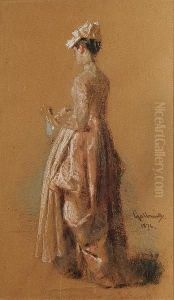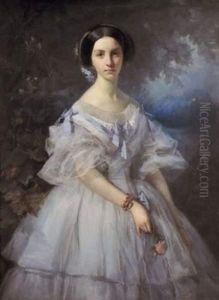Alphonse-Louis Galbrund Paintings
Alphonse-Louis Galbrund, a somewhat obscure figure in the annals of art history, was born in 1810. His life spanned much of the 19th century, a period ripe with artistic innovation and the blossoming of Romanticism, yet he remains a lesser-known artist outside of specialized circles. His contributions, while not as widely recognized as those of his contemporaries, offer a unique glimpse into the artistic movements and styles that influenced the era.
Galbrund's work primarily centered around painting and illustration, with a noticeable inclination towards landscapes and portraits. He was deeply influenced by the Romantic movement, which emphasized emotion, individualism, and the sublime beauty of nature. This influence is evident in his choice of subjects and the emotive quality of his landscapes, which often sought to capture the awe-inspiring power and majesty of the natural world. Galbrund's portraits, on the other hand, are notable for their detailed realism and the ability to capture the essence of the subject's character.
Throughout his career, Galbrund struggled with the recognition of his work. Despite the quality of his paintings, he often found himself overshadowed by more prominent figures of the time. This lack of widespread acclaim did not deter him; he continued to produce a substantial body of work, which was appreciated by a more discerning audience. His dedication to his art and his persistence in the face of obscurity is a testament to his passion and commitment to his craft.
Galbrund's later years were marked by a gradual shift in his style, as he began to experiment with early forms of Impressionism. This transition showcased his willingness to evolve and adapt his techniques in response to changing artistic trends. Despite this adaptation, his work remained true to the themes of Romanticism, reflecting his lifelong fascination with the interplay between man, nature, and emotion.
Alphonse-Louis Galbrund passed away in 1885, leaving behind a legacy that, while not as celebrated as that of his contemporaries, offers valuable insights into the diverse and dynamic world of 19th-century art. Today, his works are mostly found in private collections and specialized museums, awaiting rediscovery by a wider audience who can appreciate the depth and sincerity of his artistic endeavors.

